Canaan, New Hampshire (1793) (GPS location N43° 39′ 55″, W72° 2′ 35″)
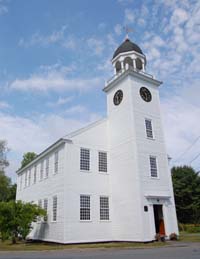 Name of Meetinghouse: Canaan Meeting House
Street Address of Meetinghouse: Near 450 Canaan St. (at intersection with Roberts Road), Canaan, NH
Name of Meetinghouse: Canaan Meeting House
Street Address of Meetinghouse: Near 450 Canaan St. (at intersection with Roberts Road), Canaan, NH
Year(s) Built: 1793
National Register of Historic Places Designation: 1971
New Hampshire State Register of Historic Places: ?
Organization responsible: Meeting House Restoration Committee
Organization's address: Town Office, PO Box 38, Canaan, NH 03741
Organization's web site: pending
Town Information: Town of Canaan
Additional historical information: Canaan Historical Society
Tax status: Municipal Government - tax exempt
Contact: Thomas Geoghegan, 810 South Road, Canaan, NH 03741
Telephone:
E-mail:
This page was last modified on: Mar 08, 2013
Acknowledgements: This text has been taken from personal correspondence with Thomas Geoghegan
 The Canaan Meeting House, built in 1793-96, was of a "typical" meetinghouse design, with the long wall facing south, doors on the east, south, and west walls, galleries also on those walls, and box pews both downstairs and in the galleries.
The structure was framed in 1793 by William Parkhurst of Chelmsford, Massachusetts.
The pulpit on the interior north wall was identical to the pulpit of the Chelmsford meetinghouse, with two staircases.
Obviously, Mr. Parkhurst brought the plans with him to Canaan.
The rest of the interior plan, however, was almost identical to the meetinghouse in Alna, Maine.
This is a rather remarkable coincidence, given the considerable distance between Canaan, in west-central New Hampshire, and Alna, near the coast in Maine.
The Canaan Meeting House, built in 1793-96, was of a "typical" meetinghouse design, with the long wall facing south, doors on the east, south, and west walls, galleries also on those walls, and box pews both downstairs and in the galleries.
The structure was framed in 1793 by William Parkhurst of Chelmsford, Massachusetts.
The pulpit on the interior north wall was identical to the pulpit of the Chelmsford meetinghouse, with two staircases.
Obviously, Mr. Parkhurst brought the plans with him to Canaan.
The rest of the interior plan, however, was almost identical to the meetinghouse in Alna, Maine.
This is a rather remarkable coincidence, given the considerable distance between Canaan, in west-central New Hampshire, and Alna, near the coast in Maine.
 The origins of this similarity can be theorized as follows.
The Alna meetinghouse, completed just before the work began in Canaan, had as its first minister one Jonathan Ward, a 1792 graduate in theology at Dartmouth College, not far from Canaan, New Hampshire.
It would seem most logical that Mr. Ward, who had to pass through Canaan after graduation, would have been introduced to the town elders, particularly deacon Caleb Welch and his committee who were planning the new meetinghouse.
It also seems plausible that, upon arrival in Alna, Mr. Ward could have sent back to the people in Canaan Joseph Carleton's plans for the Alna meetinghouse.
Since Canaan lacked an architect, this theory would explain how the two structures could have identical interior designs.
The origins of this similarity can be theorized as follows.
The Alna meetinghouse, completed just before the work began in Canaan, had as its first minister one Jonathan Ward, a 1792 graduate in theology at Dartmouth College, not far from Canaan, New Hampshire.
It would seem most logical that Mr. Ward, who had to pass through Canaan after graduation, would have been introduced to the town elders, particularly deacon Caleb Welch and his committee who were planning the new meetinghouse.
It also seems plausible that, upon arrival in Alna, Mr. Ward could have sent back to the people in Canaan Joseph Carleton's plans for the Alna meetinghouse.
Since Canaan lacked an architect, this theory would explain how the two structures could have identical interior designs.
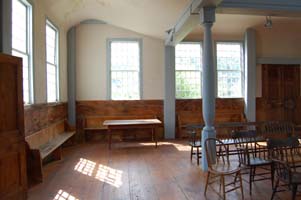 The interior finishing of Canaan was completed in 1796 by Levi George, of Salisbury, New Hampshire.
He went on to contribute to the lovely town house in Strafford, Vermont.
The interior finishing of Canaan was completed in 1796 by Levi George, of Salisbury, New Hampshire.
He went on to contribute to the lovely town house in Strafford, Vermont.
From 1796 to around 1815, the Canaan Meetinghouse was shared by various denominations (Baptists, Congregationalists, and so on).
Not always in agreement about use, the meetinghouse began to face an uncertain future.
When New Hampshire abolished ministers' taxes in 1819, the Town of Canaan found itself in the position of deciding whether to accept formal ownership of the structure.
They did so in 1827.
In 1829, the sounding board above the pulpit was taken down because some feared it might fall and hurt someone.
A broken pediment was put in its place.
In about 1840, the pulpit and the downstairs box pews were removed, along with the gallery breastwork and the gallery front box pews.
Where the breastwork was sawed off at its base, a plank ceiling was put across to close off the gallery space so that the downstairs could be heated with a wood stove.
A crude slanted floor with rough benches was installed downstairs on the south side by toe nailing it to the walls.
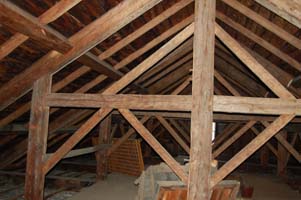 Around 1850, the town procured a bell for the meetinghouse.
Until this point, the Canaan meetinghouse still retained both of its two-storied porch staircase extensions that were on the east and west ends of the building, as can be seen today in Rockingham, Vermont and Fremont, New Hampshire.
With the arrival of the bell, the idea was to make the east porch twice as tall so as to make the meetinghouse look more like a typical church building of the mid-1800s.
The west porch was removed, and its timbers were used to heighten the east porch to make a tower.
The remaining box pews along the upstairs walls were removed at this time, and parts of them were used to sheath the tower.
The bare space on the west end where the porch had been was clapboarded over re-using the 1793 hand-forged nails.
Around 1850, the town procured a bell for the meetinghouse.
Until this point, the Canaan meetinghouse still retained both of its two-storied porch staircase extensions that were on the east and west ends of the building, as can be seen today in Rockingham, Vermont and Fremont, New Hampshire.
With the arrival of the bell, the idea was to make the east porch twice as tall so as to make the meetinghouse look more like a typical church building of the mid-1800s.
The west porch was removed, and its timbers were used to heighten the east porch to make a tower.
The remaining box pews along the upstairs walls were removed at this time, and parts of them were used to sheath the tower.
The bare space on the west end where the porch had been was clapboarded over re-using the 1793 hand-forged nails.
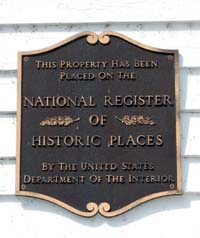 The next change to befall the Canaan meetinghouse was the crude 1885 addition of a new backend to the building, and an upstairs parquet dance floor.
In 1893, a clock was installed in the tower, which meant that the tower could no longer be used as a staircase because the clock weights needed the space.
The solution was to build an enclosed stairwell on the outside east front of the meetinghouse, with a ticket booth at toe top to sell tickets to events held upstairs.
Electrical wiring with Edison bulbs was also added.
The next change to befall the Canaan meetinghouse was the crude 1885 addition of a new backend to the building, and an upstairs parquet dance floor.
In 1893, a clock was installed in the tower, which meant that the tower could no longer be used as a staircase because the clock weights needed the space.
The solution was to build an enclosed stairwell on the outside east front of the meetinghouse, with a ticket booth at toe top to sell tickets to events held upstairs.
Electrical wiring with Edison bulbs was also added.
The restoration of the Canaan meetinghouse had its beginnings through the efforts of Elsie Goodhue Crocker (1899 - 1980), who, in the 1950s and 60s brought public attention to the deteriorating condition of the building.
Her patient fundraising formed the financial basis for the renovation and restoration of the building, which began in the 1970s.
The restoration committee was headed by Bill Geoghegan, father of Thomas Geoghegan, who now heads the Meeting House Restoration Committee.
By 1970, it was evident that the evolution of the Canaan meetinghouse, coupled with the growth of the town, made the structure unsuitable for much of anything.
With the roof leaking, the upstairs floor collapsing, and the plaster coming off the walls and ceiling, some people were calling for its demolition.
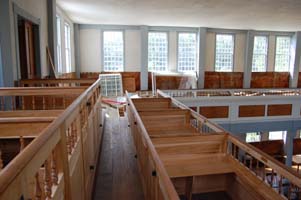 Fortunately, the committee of dedicated individuals has rescued the building from destruction.
When the 1885 upstairs floor was removed in the early 1980s, an enormous amount of evidence was gathered that, fortunately, had not been disposed of.
Spindles, pieces of panels, moldings, and so on have helped to ascertain just what the original design had been.
In the past 20 years or so much of the interior has been restored to its original early-1800s appearance
Also, the roof and foundation have been stabilized, and an authentic-looking west porch has been re-created that contains bathroom and kitchen facilities.
These modern conveniences have been added in such a way that they do not detract from the early 19th century restoration, and thus preserve the historic accuracy of the building while at the same time make the building useful for present-day gatherings.
Current restoration efforts focus on the reconstruction of the box pews in the galleries, which are being "purchased" by local families in much the same way that the meetinghouse originally would have been financed.
The downstairs will be left open, with no attempt to recreate the pulpit or box pews, which would make the structure less useful.
Fortunately, the committee of dedicated individuals has rescued the building from destruction.
When the 1885 upstairs floor was removed in the early 1980s, an enormous amount of evidence was gathered that, fortunately, had not been disposed of.
Spindles, pieces of panels, moldings, and so on have helped to ascertain just what the original design had been.
In the past 20 years or so much of the interior has been restored to its original early-1800s appearance
Also, the roof and foundation have been stabilized, and an authentic-looking west porch has been re-created that contains bathroom and kitchen facilities.
These modern conveniences have been added in such a way that they do not detract from the early 19th century restoration, and thus preserve the historic accuracy of the building while at the same time make the building useful for present-day gatherings.
Current restoration efforts focus on the reconstruction of the box pews in the galleries, which are being "purchased" by local families in much the same way that the meetinghouse originally would have been financed.
The downstairs will be left open, with no attempt to recreate the pulpit or box pews, which would make the structure less useful.
|
 Name of Meetinghouse: Canaan Meeting House
Name of Meetinghouse: Canaan Meeting House
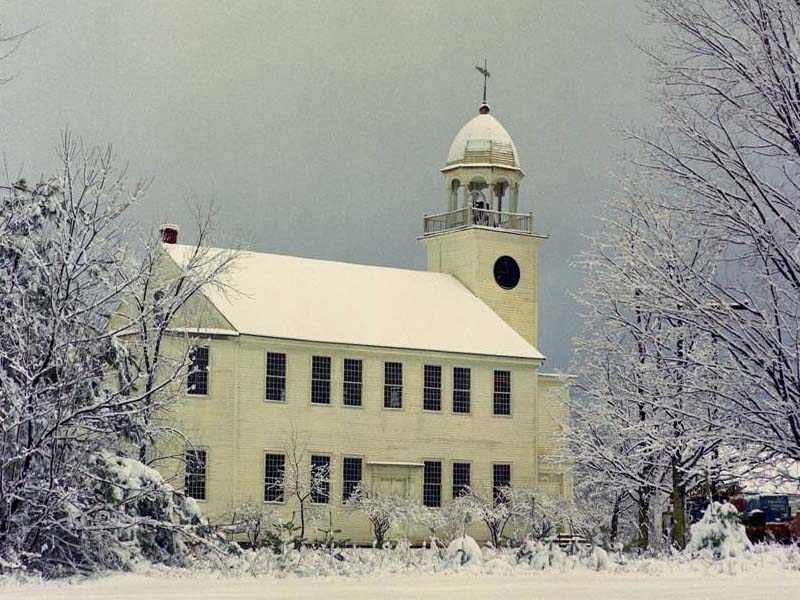

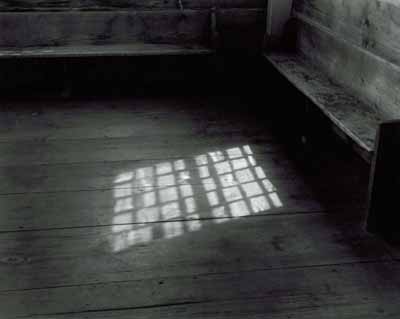
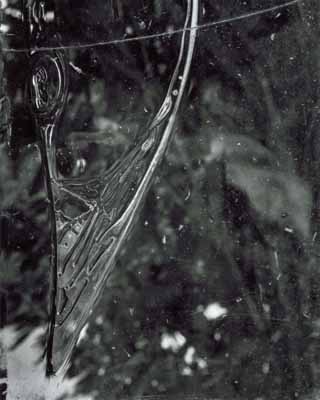
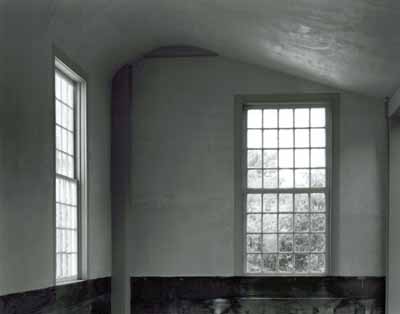
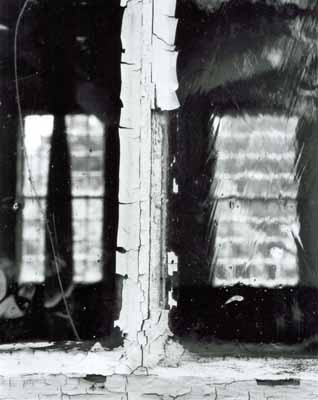
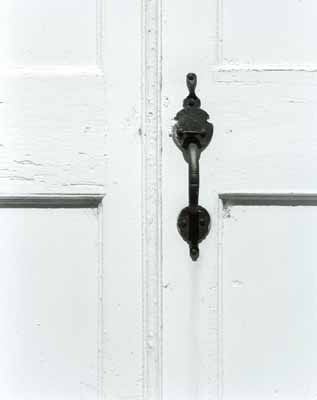
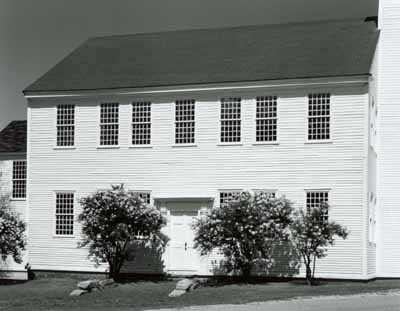
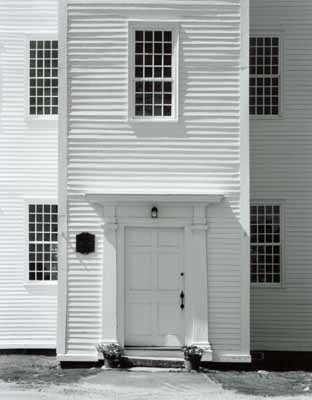
 The Canaan Meeting House, built in 1793-96, was of a "typical" meetinghouse design, with the long wall facing south, doors on the east, south, and west walls, galleries also on those walls, and box pews both downstairs and in the galleries.
The structure was framed in 1793 by William Parkhurst of Chelmsford, Massachusetts.
The pulpit on the interior north wall was identical to the pulpit of the Chelmsford meetinghouse, with two staircases.
Obviously, Mr. Parkhurst brought the plans with him to Canaan.
The rest of the interior plan, however, was almost identical to the meetinghouse in Alna, Maine.
This is a rather remarkable coincidence, given the considerable distance between Canaan, in west-central New Hampshire, and Alna, near the coast in Maine.
The Canaan Meeting House, built in 1793-96, was of a "typical" meetinghouse design, with the long wall facing south, doors on the east, south, and west walls, galleries also on those walls, and box pews both downstairs and in the galleries.
The structure was framed in 1793 by William Parkhurst of Chelmsford, Massachusetts.
The pulpit on the interior north wall was identical to the pulpit of the Chelmsford meetinghouse, with two staircases.
Obviously, Mr. Parkhurst brought the plans with him to Canaan.
The rest of the interior plan, however, was almost identical to the meetinghouse in Alna, Maine.
This is a rather remarkable coincidence, given the considerable distance between Canaan, in west-central New Hampshire, and Alna, near the coast in Maine.
 The origins of this similarity can be theorized as follows.
The Alna meetinghouse, completed just before the work began in Canaan, had as its first minister one Jonathan Ward, a 1792 graduate in theology at Dartmouth College, not far from Canaan, New Hampshire.
It would seem most logical that Mr. Ward, who had to pass through Canaan after graduation, would have been introduced to the town elders, particularly deacon Caleb Welch and his committee who were planning the new meetinghouse.
It also seems plausible that, upon arrival in Alna, Mr. Ward could have sent back to the people in Canaan Joseph Carleton's plans for the Alna meetinghouse.
Since Canaan lacked an architect, this theory would explain how the two structures could have identical interior designs.
The origins of this similarity can be theorized as follows.
The Alna meetinghouse, completed just before the work began in Canaan, had as its first minister one Jonathan Ward, a 1792 graduate in theology at Dartmouth College, not far from Canaan, New Hampshire.
It would seem most logical that Mr. Ward, who had to pass through Canaan after graduation, would have been introduced to the town elders, particularly deacon Caleb Welch and his committee who were planning the new meetinghouse.
It also seems plausible that, upon arrival in Alna, Mr. Ward could have sent back to the people in Canaan Joseph Carleton's plans for the Alna meetinghouse.
Since Canaan lacked an architect, this theory would explain how the two structures could have identical interior designs.
 The interior finishing of Canaan was completed in 1796 by Levi George, of Salisbury, New Hampshire.
He went on to contribute to the lovely town house in Strafford, Vermont.
The interior finishing of Canaan was completed in 1796 by Levi George, of Salisbury, New Hampshire.
He went on to contribute to the lovely town house in Strafford, Vermont.
 Around 1850, the town procured a bell for the meetinghouse.
Until this point, the Canaan meetinghouse still retained both of its two-storied porch staircase extensions that were on the east and west ends of the building, as can be seen today in Rockingham, Vermont and Fremont, New Hampshire.
With the arrival of the bell, the idea was to make the east porch twice as tall so as to make the meetinghouse look more like a typical church building of the mid-1800s.
The west porch was removed, and its timbers were used to heighten the east porch to make a tower.
The remaining box pews along the upstairs walls were removed at this time, and parts of them were used to sheath the tower.
The bare space on the west end where the porch had been was clapboarded over re-using the 1793 hand-forged nails.
Around 1850, the town procured a bell for the meetinghouse.
Until this point, the Canaan meetinghouse still retained both of its two-storied porch staircase extensions that were on the east and west ends of the building, as can be seen today in Rockingham, Vermont and Fremont, New Hampshire.
With the arrival of the bell, the idea was to make the east porch twice as tall so as to make the meetinghouse look more like a typical church building of the mid-1800s.
The west porch was removed, and its timbers were used to heighten the east porch to make a tower.
The remaining box pews along the upstairs walls were removed at this time, and parts of them were used to sheath the tower.
The bare space on the west end where the porch had been was clapboarded over re-using the 1793 hand-forged nails.
 The next change to befall the Canaan meetinghouse was the crude 1885 addition of a new backend to the building, and an upstairs parquet dance floor.
In 1893, a clock was installed in the tower, which meant that the tower could no longer be used as a staircase because the clock weights needed the space.
The solution was to build an enclosed stairwell on the outside east front of the meetinghouse, with a ticket booth at toe top to sell tickets to events held upstairs.
Electrical wiring with Edison bulbs was also added.
The next change to befall the Canaan meetinghouse was the crude 1885 addition of a new backend to the building, and an upstairs parquet dance floor.
In 1893, a clock was installed in the tower, which meant that the tower could no longer be used as a staircase because the clock weights needed the space.
The solution was to build an enclosed stairwell on the outside east front of the meetinghouse, with a ticket booth at toe top to sell tickets to events held upstairs.
Electrical wiring with Edison bulbs was also added.
 Fortunately, the committee of dedicated individuals has rescued the building from destruction.
When the 1885 upstairs floor was removed in the early 1980s, an enormous amount of evidence was gathered that, fortunately, had not been disposed of.
Spindles, pieces of panels, moldings, and so on have helped to ascertain just what the original design had been.
In the past 20 years or so much of the interior has been restored to its original early-1800s appearance
Also, the roof and foundation have been stabilized, and an authentic-looking west porch has been re-created that contains bathroom and kitchen facilities.
These modern conveniences have been added in such a way that they do not detract from the early 19th century restoration, and thus preserve the historic accuracy of the building while at the same time make the building useful for present-day gatherings.
Current restoration efforts focus on the reconstruction of the box pews in the galleries, which are being "purchased" by local families in much the same way that the meetinghouse originally would have been financed.
The downstairs will be left open, with no attempt to recreate the pulpit or box pews, which would make the structure less useful.
Fortunately, the committee of dedicated individuals has rescued the building from destruction.
When the 1885 upstairs floor was removed in the early 1980s, an enormous amount of evidence was gathered that, fortunately, had not been disposed of.
Spindles, pieces of panels, moldings, and so on have helped to ascertain just what the original design had been.
In the past 20 years or so much of the interior has been restored to its original early-1800s appearance
Also, the roof and foundation have been stabilized, and an authentic-looking west porch has been re-created that contains bathroom and kitchen facilities.
These modern conveniences have been added in such a way that they do not detract from the early 19th century restoration, and thus preserve the historic accuracy of the building while at the same time make the building useful for present-day gatherings.
Current restoration efforts focus on the reconstruction of the box pews in the galleries, which are being "purchased" by local families in much the same way that the meetinghouse originally would have been financed.
The downstairs will be left open, with no attempt to recreate the pulpit or box pews, which would make the structure less useful.